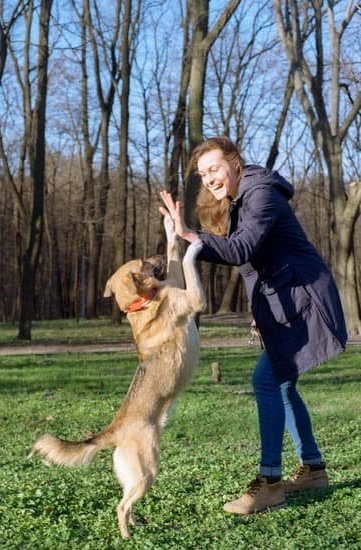Does your dog bark at everything? Discover the psychology behind a dog’s barking behavior and the various triggers that lead to incessant barking. Addressing this issue is crucial for your dog’s well-being and your peace of mind. In this article, we will explore the reasons behind excessive barking and provide effective training techniques to help you train your dog to stop barking at everything.
A dog’s bark is their way of communicating with us and the world around them. By understanding the psychology behind their barks, we can gain insight into their needs and emotions. We will delve into the different triggers that can cause dogs to bark excessively, such as fear, boredom, territoriality, or separation anxiety. This understanding will enable us to address these root causes effectively.
Addressing excessive barking is not only essential for our own sanity but also for our furry companions’ well-being. Constantly barking can indicate that something is bothering or stressing your dog. By addressing this issue, we can create a calmer and more peaceful environment for both ourselves and our four-legged friends. So let’s dive in and discover how we can train our dogs to stop barking at everything by addressing the reasons behind their excessive vocalizations.
Recognizing the Different Types of Barks and Their Meanings
Dogs communicate through barking, and understanding the different types of barks can provide valuable insights into their emotions and intentions. By recognizing the various sounds and pitches of dog barks, you can better address your furry friend’s needs and effectively train them to stop barking excessively.
Firstly, it is important to decode the different types of barks your dog emits. Some common types include alert barks, which are short, sharp bursts that indicate they have noticed something unusual or exciting in their environment. On the other hand, fear or anxiety barks are usually repetitive and high-pitched, expressing unease or insecurity. Additionally, frustrated or attention-seeking barks may be characterized by a continuous pattern with intervals.
Understanding the meanings behind each type of bark is essential for addressing your dog’s needs appropriately. Alert barks can indicate curiosity or potential danger, while fear or anxiety barks signal a need for reassurance and comfort. Frustrated or attention-seeking barks often occur when dogs are trying to communicate boredom or desire for interaction. By identifying these emotions and intentions behind each type of bark, you can respond accordingly and provide appropriate training interventions.
To better understand your dog’s language through their barking, consider keeping a journal where you note down the different situations that trigger specific types of barking episodes. Pay close attention to any patterns in their behavior and correlate them with events happening around them. This will help you pinpoint what triggers their excessive barking as well as determine the most effective strategies to curtail it.
In summary, recognizing the different types of dog barks and their meanings is crucial in training your dog to stop barking at everything. By decoding these communication cues from your furry friend, you can appropriately address their needs and emotions. Understanding your dog’s language will pave the way towards more effective training techniques that promote a peaceful coexistence between both of you.
Creating a Calm and Soothing Environment for Your Dog
Establishing a calm and soothing environment is essential when it comes to training your dog to stop barking at everything. Dogs often bark excessively due to anxiety, fear, or stress, so providing them with a safe and secure space can go a long way in curbing their barking behavior.
One way to create a peaceful environment for your furry companion is by establishing a designated area where they feel safe and comfortable. This could be a crate, a specific room, or even a cozy corner in your home. Make sure this space is filled with familiar items such as their bed, toys, and blankets. Creating this special oasis for your dog will give them a sense of security, reducing their overall stress levels.
Reducing anxiety and stress in your dog can also help minimize excessive barking. There are various techniques you can employ to achieve this, such as maintaining consistent routines and schedules. Dogs thrive on predictability, so sticking to set feeding times, exercise routines, and sleep schedules can help alleviate their anxiety.
Additionally, consider incorporating calming techniques into your dog’s routine. This could include playing soft and soothing music or using synthetic pheromone diffusers like Adaptil that emit calming scents specifically designed for dogs. These diffusers mimic the natural pheromones produced by mother dogs when they nurse their puppies, creating a reassuring atmosphere for your furry friend.
| Techniques | Benefits |
|---|---|
| Establishing a safe and secure space for your dog | Provides a sense of security, reducing stress levels |
| Maintaining consistent routines and schedules | Alleviates anxiety by providing predictability |
| Playing soft and soothing music or using pheromone diffusers | Creates a calming atmosphere for your dog |
The Power of Positive Reinforcement
Positive reinforcement is a highly effective method of training dogs, and it can be particularly useful in teaching them the “Quiet” command to curb excessive barking. This section will provide a step-by-step guide on how to utilize positive reinforcement to teach your dog this important command.
To begin, it is crucial to understand the basic principles of positive reinforcement training. This training technique involves rewarding desired behaviors in order to encourage their repetition. It focuses on providing incentives such as treats, praise, and affection whenever your dog exhibits the desired behavior, reinforcing a strong association between the behavior and the reward.
The first step in teaching your dog the “Quiet” command is to choose a specific verbal cue that you will consistently use. Common choices for this command are “Quiet” or “Enough.” Next, create a trigger or situation that typically causes your dog to bark excessively. This could be something like ringing the doorbell or having someone knock on the door.
As soon as your dog starts barking in response to the trigger, firmly say the chosen verbal cue while holding a treat close to their nose. Wait for a brief moment of silence or if possible, even just a pause in barking. As soon as your dog stops barking and remains quiet for a moment, reward them immediately with praise and give them the treat.
By consistently repeating this process every time your dog barks excessively, they will start associating the “Quiet” command with receiving treats and praise. Over time, they will begin to understand that remaining quiet when given the verbal cue leads to positive rewards.
It’s important to note that consistency is key in positive reinforcement training. Be sure to practice this exercise regularly with various triggers and gradually increase distractions as your dog becomes more proficient with responding to the “Quiet” command. With patience and dedication, you can effectively train your dog to stop barking excessively using positive reinforcement techniques.
| Step | Description |
|---|---|
| Step 1 | Choose a specific verbal cue for the “Quiet” command. |
| Step 2 | Create a trigger or situation that causes your dog to bark excessively. |
| Step 3 | Say the verbal cue while holding a treat close to your dog’s nose when they start barking. |
Implementing Distraction Techniques to Redirect Barking Behavior
Excessive barking can be a frustrating behavior for both dog owners and their neighbors. If your furry friend tends to bark incessantly at everything, implementing distraction techniques can help redirect their behavior and provide them with alternative outlets for their energy and attention.
One effective method is to utilize engaging toys and puzzles that can captivate your dog’s focus. Interactive toys, such as treat-dispensing puzzle toys or durable chew toys, not only keep your dog occupied but also provide mental stimulation. By redirecting their attention to these toys, you can shift their focus away from the triggers that typically incite barking.
Another useful strategy is incorporating positive distractions during triggering situations. For example, if your dog tends to bark when they see other dogs during walks, you can try diverting their attention by carrying small treats or using a clicker to engage them in obedience training exercises. By redirecting their focus onto more desirable behaviors, you can help curb excessive barking.
When choosing distractions for your dog, it is important to consider their preferences and individual needs. Some dogs may respond well to squeaky toys or games of fetch, while others may prefer interactive play sessions with their favorite human or pet companion. Experiment with different options to find out what captures your dog’s attention the most effectively.
Overall, implementing distraction techniques is a valuable tool in addressing a dog’s barking behavior. By providing alternative outlets for your furry friend’s energy and attention, you can help redirect their focus away from triggers that activate excessive barking. With consistent practice and patience, you will be able to achieve a quieter household and enjoy a peaceful coexistence with your beloved canine companion.
- Utilize engaging toys and puzzles that captivate your dog’s focus
- Incorporate positive distractions during triggering situations
- Choose distractions based on your dog’s preferences and needs
Socialization
Socializing your dog is a crucial aspect of training that can help reduce excessive barking. By exposing your dog to different stimuli and environments in a positive way, you can encourage confidence and curb their barking behavior. Here are some techniques for effective socialization:
Gradual Exposure
When introducing your dog to new people, animals, or environments, it’s important to take things slow. Gradual exposure allows your dog to feel comfortable and safe while experiencing new things. Start with low-stress situations and gradually increase the level of difficulty as your dog becomes more confident.
Positive Reinforcement
Using positive reinforcement during socialization can have a significant impact on reducing barking. Reward your dog with treats, praise, or playtime when they exhibit calm and appropriate behavior during interactions. This will help them associate positive experiences with socializing and build their confidence.
Enriching Experiences
Expose your dog to a variety of situations that may trigger barking, such as loud noises or unfamiliar objects. Use toys or puzzles to engage their focus and redirect their attention away from barking. By providing enriching experiences, you can help your dog develop coping mechanisms and decrease their overall reactivity.
Remember to always monitor your dog’s comfort level during socialization activities. If they show signs of stress or fear, take a step back and adjust the intensity of the experience accordingly. It’s important to create positive associations with socializing in order to encourage confidence rather than reinforcing fear or anxiety.
By incorporating socialization techniques into your training regimen, you can empower your dog with confidence and effectively reduce excessive barking. However, if you find that despite consistent efforts, your dog’s barking behavior persists or worsens, it may be time to seek professional help from a qualified dog trainer or behaviorist.
A professional will be able to assess the underlying causes of your dog’s barking and provide tailored guidance and strategies to address the issue. They can also help you navigate any specific challenges your dog may be facing during socialization. Choosing the right professional is crucial, so be sure to do your research, read reviews, and ask for recommendations from trusted sources.
Consistency and patience are key when it comes to curbing excessive barking through socialization. It may take time for your dog to fully adjust and feel confident in various situations. Celebrate small victories along the way and continue to reinforce positive behaviors. With dedication and a well-rounded approach to training, you can enjoy a peaceful coexistence with your dog while nurturing their well-being.
Seeking Professional Help
When faced with a dog that constantly barks at everything, it can sometimes feel overwhelming and difficult to handle on your own. In some cases, seeking professional help from a dog trainer or behaviorist may be necessary to address the issue effectively. Recognizing when it is appropriate to reach out for assistance is crucial in ensuring the well-being of your furry friend and restoring peace in your home.
Recognizing when professional assistance may be necessary
There are certain situations where seeking professional help becomes essential in dealing with a dog’s excessive barking. If your attempts at training and redirecting the behavior have not been successful or if the problem persists over an extended period, it may be time to consider consulting a dog trainer or behaviorist.
Additionally, if you notice alarming behavior such as aggression accompanying the barking, seeking professional help is strongly recommended. A qualified expert will be able to assess your dog’s behavior holistically and provide tailored strategies and guidance based on their expertise.
The benefits of working with a qualified dog trainer or behaviorist
Working with a professional who specializes in dog training or behavior modification can offer numerous benefits when it comes to addressing excessive barking. These experts have a deep understanding of canine psychology and behavior patterns, allowing them to identify the root causes behind the incessant barking. By delving into the underlying reasons for the behavior, they can develop targeted training plans to address these specific triggers effectively.
Furthermore, a qualified dog trainer or behaviorist can provide you with valuable insights into your own interactions with your canine companion that may inadvertently encourage or reinforce the barking behavior. They will guide you on how to modify your response and create an environment that promotes calmness and quietness.
How to choose the right professional to address your dog’s barking issues
When selecting a dog trainer or behaviorist to assist you with your dog’s barking issues, it is essential to do thorough research and find a qualified and experienced professional. Look for certifications, credentials, and positive reviews from past clients. It can also be helpful to ask for recommendations from trusted friends, family members, or your veterinarian.
Consider scheduling initial consultations with a few potential professionals to discuss your dog’s behavior and your training goals. This will allow you to get a sense of their approach and determine if you feel comfortable working with them. Remember that effective training requires a good rapport between the trainer/behaviorist, the dog, and the owner.
By reaching out for professional help when necessary, you are taking proactive steps towards addressing your dog’s excessive barking. With their expertise and guidance, you can work together to create a calm environment and build better communication with your furry companion.
Consistency and Patience
Building a lasting behavior change requires consistency and patience when it comes to addressing your dog’s excessive barking. While training your dog to stop barking at everything may take time, the effort put in will be worthwhile in creating a peaceful coexistence with your furry companion.
Consistency is key when it comes to training your dog. It is important to establish a routine that you can stick to and follow through with. Consistency helps your dog understand what behaviors are expected from them and what behaviors are not acceptable. For example, if you want to teach your dog the “quiet” command, it is essential that you use the same word consistently every time they bark excessively, along with the same gesture or cue.
In addition to consistency, patience is another virtue that is crucial in modifying your dog’s barking behavior. It is important to understand that changing a behavior takes time and effort. Dogs learn at different paces, so it is important not to get frustrated or discouraged if progress seems slow.
Instead, focus on the small victories along the way and celebrate them. By being patient and persevering through the training process, you will be able to build a lasting behavior change in your dog.
Remember, consistency and patience go hand in hand when it comes to training your dog to stop barking at everything. Being consistent with your training routines and patient throughout the process will help create a peaceful environment for both you and your furry companion. Celebrate the progress you make together and enjoy the quiet moments that come with a well-behaved canine companion.
Conclusion
In conclusion, training your dog to stop barking at everything is a journey that requires understanding, patience, and consistency. By uncovering the reasons behind excessive barking and recognizing the different types of barks and their meanings, you can better understand your dog’s behavior and address it effectively. Creating a calm and soothing environment for your dog is vital in curbing excessive barking, as it helps reduce anxiety and stress.
Positive reinforcement training, such as teaching your dog the “quiet” command, is a powerful tool in modifying their behavior. By introducing this concept and consistently practicing it, you can encourage your dog to remain quiet when triggered. Implementing distraction techniques also plays a crucial role in redirecting their focus away from barking. Choosing engaging toys or positive distractions during triggering situations can be effective methods.
Socialization is another key aspect to address excessive barking. Gradually exposing your dog to different stimuli and environments empowers them with confidence and reduces their reactivity. When all else fails, seeking professional help from a qualified dog trainer or behaviorist should be considered. Their expertise can provide valuable insights and personalized guidance to meet your specific needs.
Remember, building a lasting behavior change takes time and consistency. Celebrate every small victory along the way towards a quieter canine companion. By maintaining a harmonious relationship built on understanding and communication, you can ultimately enjoy a peaceful coexistence with your dog in a bark-free household in the long term. So take the first step today towards creating harmony for both your furry friend’s well-being and your peace of mind.
Frequently Asked Questions
How do I get my dog to stop barking at everything at home?
To get your dog to stop barking at everything at home, it is important to understand the underlying causes of this behavior. Dogs may bark excessively due to boredom, fear, anxiety, territorial instincts, or even as a form of communication. First, identify the triggers that make your dog bark and try to address them one by one.
For example, if your dog barks at people passing by the window, you can block their view or close the curtains. Providing mental and physical stimulation through regular exercise and interactive toys can help alleviate boredom-related barking. Additionally, positive reinforcement training techniques can be effective in teaching your dog an alternative behavior to replace excessive barking.
Can you train a dog not to bark at everything?
Yes, dogs can be trained not to bark at everything with consistent effort and patience from their owners. Training should focus on teaching your dog when it is appropriate to bark and when it is not. Start by teaching a “quiet” command where you reward your dog for stopping barking on cue.
This helps them understand that barking has a time limit and they can control it. Practice this command in various scenarios gradually exposing them to different stimuli that might trigger their barking response until they learn impulse control. Positive reinforcement – such as treats, praise, or play – should be used consistently to reinforce desired behavior when your dog remains quiet.
How do I get my dog to stop barking at all noises?
To stop your dog from barking at all noises, desensitization techniques can be helpful in reducing their reactivity towards sounds that trigger excessive barking. Start by introducing low levels of those noises gradually while reassuring your dog using calm and confident body language and soothing tones of voice.
Gradually increase the volume over time as long as your dog remains calm and doesn’t display signs of distress or excessive arousal like growling or lunging. Pairing these sounds with positive experiences like treats or playtime can also help associate noise with positive outcomes instead of triggering anxious behavior.

Welcome to the blog! I am a professional dog trainer and have been working with dogs for many years. In this blog, I will be discussing various topics related to dog training, including tips, tricks, and advice. I hope you find this information helpful and informative. Thanks for reading!





